Eric C. Sheninger's Blog, page 16
April 3, 2022
Shifting Our Focus
Humans, by nature, are heavily influenced by experience. As such, we often do things a certain way because that is either all we know or what we are comfortable doing. Think about this for a second when it comes to behavior in education. We often teach the way we were taught and lead in a way that we were led. I’d wager that many of you reading this post are bobbing your head in agreement, although there are always exceptions. Change is hard, especially if we have been influenced in a certain way. Trying something new or different can instill a sense of fear or an uncomfortable feeling, which in turn keeps us firmly entrenched in our ways. While this is certainly natural, it can possibly inhibit growth.
Just because we were taught a certain way or told how to lead a learning culture effectively doesn’t mean we shy away from challenging conventional norms. As I have stated repeatedly over the years, TTWWADI (that’s the way we’ve always done it) is one of the most dangerous phrases in education. Changing behavior begins with shifting our focus with less emphasis on instruction and more on learning. While the former still has value, the latter leads to improved outcomes and success. Remember, instruction is what the teacher does, and learning is what the student not only does but shows. Hence, there is a need to prioritize the “who” instead of the “what.”
A great way to conceptualize this is through the lens of personalization. An impersonal approach is all students doing the same thing the same way at the same time. While this can have merit in moderation, excessive use of one-size-fits-all approaches is inequitable. They also tend to focus on the “what .”On the other hand, personalization is where all learners get what they need when and where they need it through equitable experiences. There is also clarity in terms of why they are learning what they are and how it will be used outside of school.
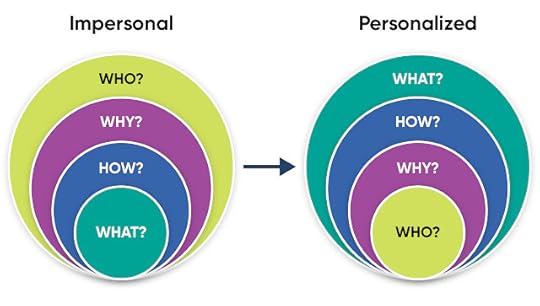
As I detailed in Disruptive Thinking in Our Classrooms, personalized learning represents a movement from the “what” to the “who” as a means to facilitate student ownership of the learning process. The image above represents a significant shift in terms of how we think about the purpose of education. Traditionally it revolved around “what” is taught, in the curriculum, on the test, or needed for promotion or graduation.
This shift results in not only a refined focus but also some significant benefits such as:
Acquiring, using, and creating new knowledgeRelevant application of learning to solve real-world problemsBuilding on diverse strengths and needs of all studentsFostering independence and self-regulation, resulting in greater ownership of learningDifferent ways to facilitate learning through high-agency strategies such as voice, choice, path, pace, and place.Seamless alignment with the RTI/MTSS process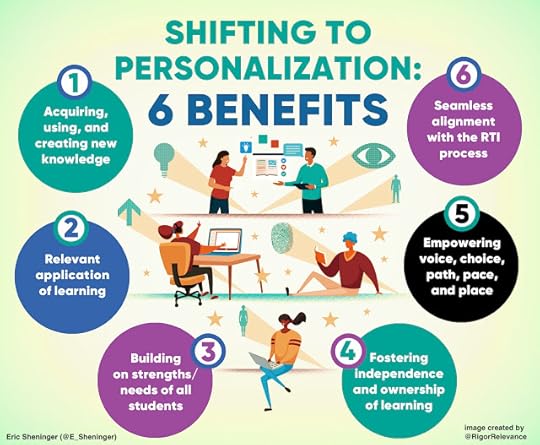
A shift to a more personalized approach can fuel better outcomes and results while future-proofing learning in the process. While technology can be leveraged, it is not the end-all or be-all. Always remember that you can personalize without digital tools. Pedagogy trumps technology. In the end, the priority is, and always will be, providing an equitable learning experience for all students.
March 27, 2022
Change Begins with You
When we do things a certain way, we often become comfortable, especially if we are satisfied with the result. While this might seem perfectly fine on the surface, the truth is that progress can become stagnant. The fact of the matter is that change will always be needed as employing the same old thinking will continue to lead to the same old results. My hope is that if you are reading this post, you are open to growth and the pursuit of innovative practices. That, in my opinion, is the easy part. The heaving lifting lies in moving the masses towards a common goal.
The hardest challenge you will face is not changing yourself, but convincing or empowering others to embrace change.
Changing perception and behavior amongst those you work with and for can possibly be the most complex task you ever take on. Change is hard. There is no way to sugarcoat this fact. It is even harder for people who don’t see the value in doing things differently or are burnt out. The need to push forward is simple yet profound. Every student in every classroom and school deserves excellence. While there will always be a myriad of obstacles, the struggle and effort will pay off.
So, where does one begin? I shared the following in Digital Leadership:
A true testament to an exceptional leader, regardless of position, is their ability to convince, persuade, or inspire others to change, especially those who do not want to. It’s not now about trying to get buy-in but moving others to see the value in the change through embracement.
The most challenging yet gratifying work you might ever engage in is empowering your colleagues to change. Below are some strategies for you to consider when trying to assist your colleagues with changing their professional practice.
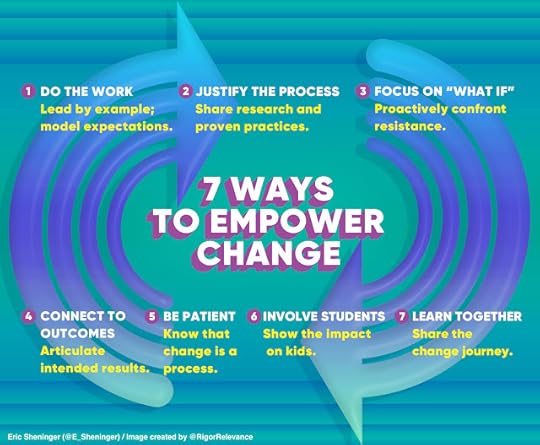
Do instead of asking. Impactful change comes from your ability to effectively model expectations for others. While it might be lonely at first, leading by example is the best way to empower others.Justify with research and proven practices. Sharing what has been found to work strengthens your call to action.Focus on “what if". Tackle fears and resistance head-on to alleviate concerns by being ready to counter any “yeah but” responses. Connect to outcomes. Clearly articulate how the change will improve professional practice resulting in improved student learning and achievement.Be patient (to a point). Change is a process, not an event. Treat your colleague like a student and remember how satisfying and rewarding it was when you helped that student succeed. Help others see the value of the change on their own by taking a step back. Get students involved. There is no better way, in my opinion, to convince others to change when educators can see firsthand the impact it has on kids.Learn together. Encourage colleagues resistant to change to attend professional learning opportunities with you, especially administrators. If that doesn’t work, make sure you present what you learned at any recent learning experience, either during a faculty meeting or one-on-one.
As with any advice, context matters. Keep this in mind as you look to implement the strategies presented above. When it is all said and done, always remember that the most difficult work with the change process involves moving the masses to scale the initiative for the betterment of all learners. If you are willing to put in the time and work while acknowledging some of the aggravation and stress that naturally comes with dealing with difficult people, a potential positive outcome will be that much sweeter.
March 20, 2022
Level Up Your Leadership
Like most kids, past, and present, I loved playing video games. During my very early years, Atari was the best and only option. My parents eventually bought an Apple IIe where we needed to use floppy disks to load any meaningful content, which added to our gaming experience. However, once the Nintendo was invented and stationed in our basement, we toiled away immersed in classics such as Super Mario Brothers, Donkey Kong, and Mike Tyson’s punchout. Our goal was simple…acquire skills through analysis, practice, and watching others to reach new or more challenging levels. I can still feel the rush when success was achieved and the bitter disappointment when I came up short. In the case of the latter, this became motivation to press forward.
We can take lessons learned from gaming and apply them to our own practice. If we don’t push ourselves to grow and get better, it becomes increasingly difficult to empower those we work with to do the same. You get what you model, for better or for worse.
If leaders don’t get It, change rarely happens.
In a world where technology is embedded in so many facets of society, it is incumbent upon leaders to look for ways to level up. Social media is, and still represents, one of the most powerful ways to move a learning culture forward and engage with stakeholders. For those who are still not seeing any value or are apprehensive by having their toe in the water instead of jumping all the way in, there is no better time than the present to make a change. I encourage you to shift your mindset in order to create schools that work better for kids and, in the process, establish relevance as a leader, no matter your position.
In Digital Leadership, I presented an array of research and evidence-based strategies that can pave the way for any leader to level up. I revisit some of these strategies as both a reminder and health-check for you to reflect on where you are, but more importantly, where you would like to be in the near future.
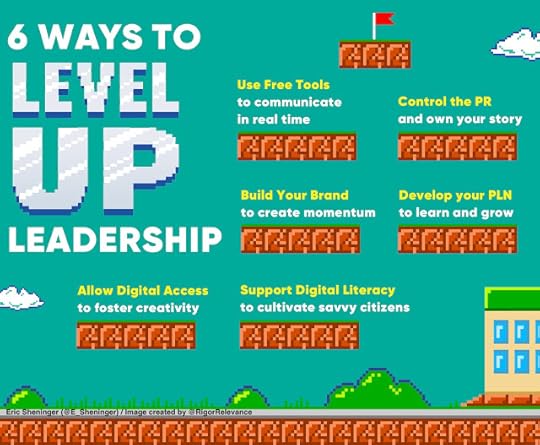 Strategically utilize an array of free tools such as Twitter, Facebook, Instagram, and Tik Tok to communicate real-time information that stakeholders can access on any device. Consistency aligned with intent is vital. Become the storyteller-in-chief and take control of your public relations. If you don't share your story, someone else will, and you then run the chance that it will not be the one you want to be told. Stop reacting to public relations situations you have limited control of and begin to be more proactive. When supplying a constant stream of positive news, you will help to mitigate any negative stories that might arise. Any leader can harness the power of a brandED by telling, not selling, in order to build powerful relationships with stakeholders and empower learning like never before. A brand presence is no longer restricted to the business world as everyone has access to the tools at their fingertips to do this in a way that won’t break the bank. Simply communicating and telling your story with social media tools can accomplish this and organically develop your positive brand in the process. If you are the brightest and most innovative person in the room, you are in the wrong room! Develop or enhance your Personal Learning Network (PLN) to connect with experts, peers, and practitioners across the globe to grow professionally through knowledge acquisition, resource sharing, engaged discussion, and to receive feedback. If you are an administrator, work to loosen up filtering policies and allow educators to use digital tools that can engage learners, unleash their creativity, and enhance learning. As many schools know, CIPA does not require many of these to be blocked. That’s a local decision. There is a golden opportunity to teach kids about digital responsibility and positively address their social and emotional needs when digital tools are used with purpose across the curriculum.
Strategically utilize an array of free tools such as Twitter, Facebook, Instagram, and Tik Tok to communicate real-time information that stakeholders can access on any device. Consistency aligned with intent is vital. Become the storyteller-in-chief and take control of your public relations. If you don't share your story, someone else will, and you then run the chance that it will not be the one you want to be told. Stop reacting to public relations situations you have limited control of and begin to be more proactive. When supplying a constant stream of positive news, you will help to mitigate any negative stories that might arise. Any leader can harness the power of a brandED by telling, not selling, in order to build powerful relationships with stakeholders and empower learning like never before. A brand presence is no longer restricted to the business world as everyone has access to the tools at their fingertips to do this in a way that won’t break the bank. Simply communicating and telling your story with social media tools can accomplish this and organically develop your positive brand in the process. If you are the brightest and most innovative person in the room, you are in the wrong room! Develop or enhance your Personal Learning Network (PLN) to connect with experts, peers, and practitioners across the globe to grow professionally through knowledge acquisition, resource sharing, engaged discussion, and to receive feedback. If you are an administrator, work to loosen up filtering policies and allow educators to use digital tools that can engage learners, unleash their creativity, and enhance learning. As many schools know, CIPA does not require many of these to be blocked. That’s a local decision. There is a golden opportunity to teach kids about digital responsibility and positively address their social and emotional needs when digital tools are used with purpose across the curriculum. In a disruptive world, societal change happens fast, and this has a ripple effect on education. Leveling up your leadership flies in the face of the status quo, and “that’s the way we have always done it” to constantly move schools in a better direction. By consistently chasing growth, you not only learn how to become a better leader, but you also empower those who you serve in the process.
Together we can continue to be the change we want to see in education.
March 13, 2022
Virtual Learning Done Right
Through adversity, we rise to the occasion. So many important lessons were learned during the pandemic that can be used to not only improve our practice but also to pave the way for a brighter future. The key is not to have a short memory while working to push forward with implementing initiatives that benefit all learners. One important lesson learned was that face-to-face learning does not meet the needs of every child.
I have been inspired to see how districts and schools have acted upon this fact and created a standalone virtual option for students to accommodate health, safety, and emotional concerns. For others, the added flexibility allows them to thrive in ways that brick-and-mortar does not. No matter the reasons, virtual options illustrate a large-scale effort to provide personalized options that focus on equity.
The move to remote learning at the height of the pandemic allowed us to work out kinks pertaining to creating and sustaining effective virtual environments. Through my work with schools on remote and now virtual learning, I have decided to create a one-stop resource that others can use based on successful programs such as the Bullitt Virtual Learning Academy in Kentucky and Davis Connect in Utah.
Clarity in expectationsSystematic use of a Learning Management System (LMS)Sound Tier 1 instruction and engagementBreakout rooms for discourse and collaborationPurposeful use of tech (voice and choice)Asynchronous personalized learning On-going professional learningFamily engagement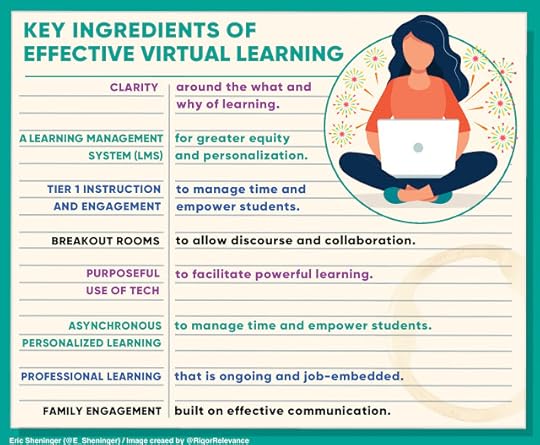
Clarity
Virtual students must understand what they are expected to learn and why they are learning the concept(s) and how it will be used outside of school. A straightforward way to set this stage is to unpack the standard(s) into a learning target. Additionally, they need to know what is expected when in synchronous and asynchronous sessions.
Learning Management System (LMS)
The consistent use of an LMS such as Google Classroom, Schoology, or Canvas works to create a more equitable virtual environment for all kids and families. It can become the hub for all lessons, videos, activities, assessments, student work, and SEL check-ins using Google or Canvas forms. A foundation can then be established for more personalized approaches such as pedagogically-sound blended learning, self-paced activities, and bitmoji classrooms. Students and families win as they have on-demand access to resources.
Tier 1 Instruction and Engagement
The success in direct or whole group instruction relies on the use of tried-and-true strategies such as the anticipatory set, reviewing prior learning, checks for understanding, modeling, and closure. While these have immense value, it is equally critical to ensure that students are empowered to think and apply their thinking in meaningful ways. As you build your virtual ecosystem and back of strategies, consider using the Rigor Relevance Framework to develop a common vision, language, and expectations that strengthen instruction and increase engagement.
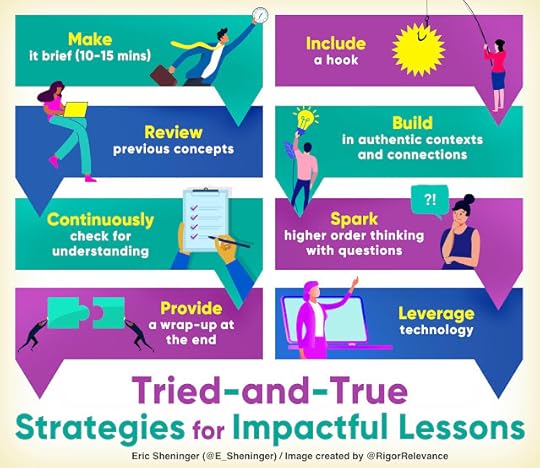
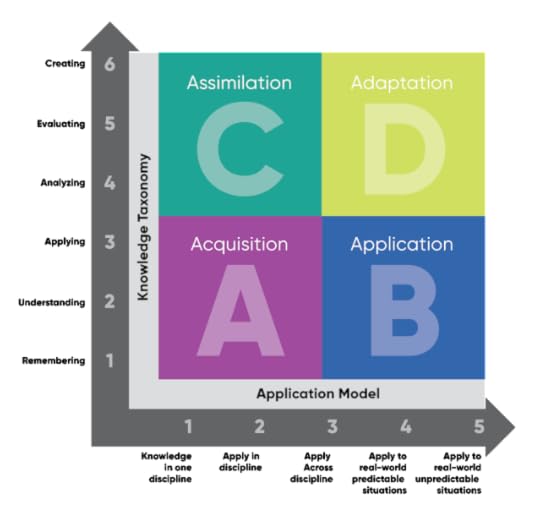
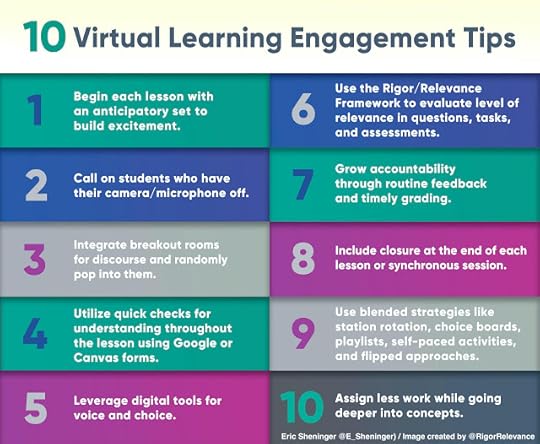
Breakout Rooms
The social aspect of learning should never be undervalued. Discussion, discourse, and collaboration during synchronous lessons are crucial to keeping kids engaged and breakout rooms are the way to make this happen. It also sets the stage for structured cooperative learning activities that could occur live or asynchronously as part of virtual learning.
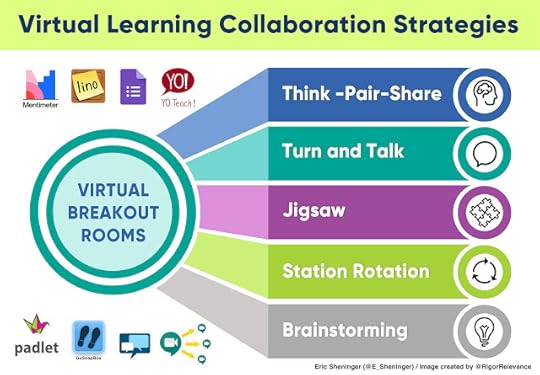
Purposeful Use of Tech
You will see a variety of images below that illustrate the power of technology in support of what has already been discussed in this post, in addition to what will be shared later. There are many digital tools available to educators these days, which often creates an overwhelming feeling. It’s not how many tools you use that matter, but instead the degree to which they are employed to facilitate engaging and empowering experiences through voice and choice.
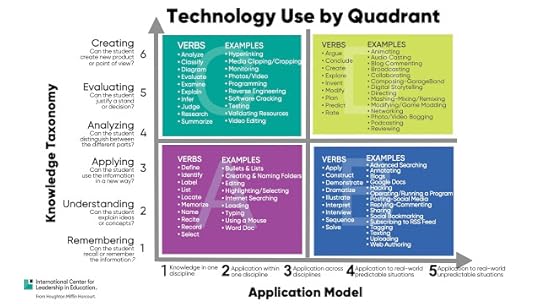
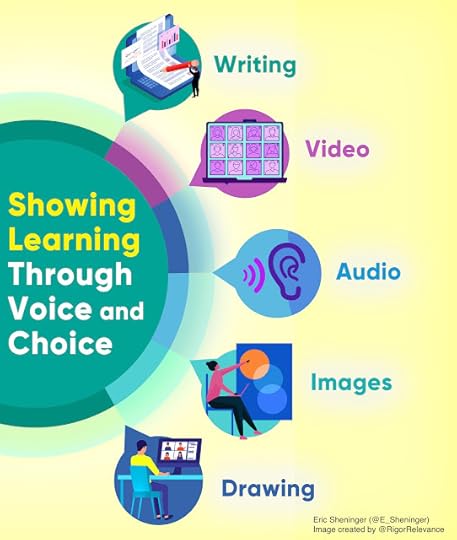
Asynchronous Personalized Learning
The critical tenet of personalized learning is all learners getting what they need when and where they need it. While strategies such as station rotation tend to be more effective when everyone is live online, other strategies such as choice activities, playlists, and the flipped approach are fantastic ways to empower students asynchronously where the teacher can still pull individual or small groups to targeted support.

Professional Learning
Typical means of professional development (PD) such as drive-by events, one-off workshops, or book studies, while having value, will not lead to impactful virtual learning at scale. There needs to be a shift from “PD” to professional learning that is ongoing, job-embedded, and research-aligned. For virtual learning to flourish, there also needs to be continual feedback, modeling of everything discussed in this post, accountability for growth, and evidence of impact.
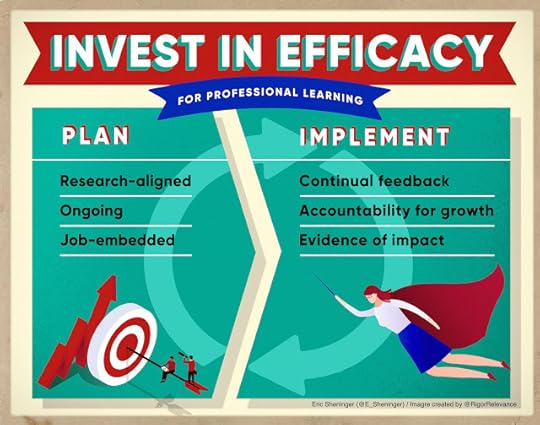
Family Engagement
As the African proverb states, “It takes a village to raise a child.” Family engagement is an essential component of any alternative learning program. At the cornerstone is effective communication, something I emphasized extensively in Digital Leadership. This involves providing routine information and educating families on how the program works, having them involved in counseling sessions, and encouraging their children to take advantage of the opportunity to move past mistakes.
Equity in learning is all students getting what they need, when and where they need it, in order to succeed in school and eventually in life. I believe every child deserves a virtual option. If districts and schools feel the same, let’s make sure it is designed in a way that challenges kids on par with face-to-face learning while also addressing social and emotional needs.
March 6, 2022
A Literate Learner
A great deal has changed since I was in school. I vividly remember getting a TANDY laptop from my parents when I graduated high school. It was a considerable upgrade from the Apple IIe that we all shared in the guest room. I was mesmerized by the black screen with orange text, the fact that I didn’t have to toil over an electric typewriter anymore. Simplistic games were also available that I could now play without being tied to a desktop monitor or television set. Even though it didn’t connect to the Internet, as I believe it either had not been invented or was readily available yet, this was my first foray in becoming literate in a bold new world.
As disruptive forces continually reshape and influence the world we all live in, being literate is of utmost importance. For a long time, the term has referred to the ability to read and write. While without question this is still accurate, we must expand our view and recognize that literacy also corresponds to competence or knowledge in a specified area. UNESCO provides a relevant description below:
Beyond its conventional concept as a set of reading, writing, and counting skills, literacy is now understood as a means of identification, understanding, interpretation, creation, and communication in an increasingly digital, text-mediated, information-rich, and fast-changing world.
Future-proofing learning is contingent upon a focus on developing competencies as opposed to just skills. I shared the following in Disruptive Thinking:
Skills focus on the “what” in terms of the abilities a student needs to perform a specific task or activity. Competencies take this to the next level by translating skills into behaviors that demonstrate what has been learned and mastered in a competent fashion. In short, skills identify what the goal is to accomplish. Competencies outline "how" the goals and objectives will be accomplished. They are more detailed and define the requirements for success in broader, more inclusive terms than skills do. To succeed in the new world of work, students will need to demonstrate the right mix of skills, knowledge, mindsets, and on-the-job ability. A skill is a practical or cognitive demonstration of what a student can do. Competency is the proven use of skills, knowledge, and abilities to illustrate mastery of learning by solving problems.
Learners of today, and tomorrow for that matter, need to be able to replace conventional ideas with innovative solutions to authentic problems. Ownership and empowerment result when we create meaningful opportunities for kids to explore, interact, design, and create in real-world contexts while being about to think disruptively. A pivotal question for any educator, school, district, or organization to ask is how is this being achieved, or where do we begin? To bring more clarity to the concept of developing a literate learner I created the following chart in Disruptive Thinking.
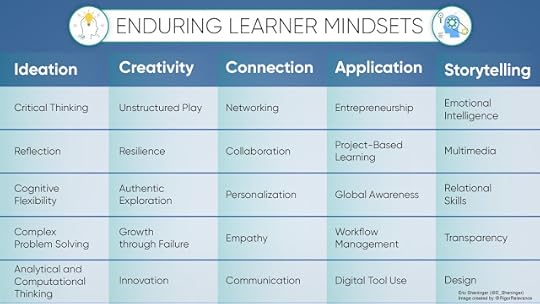
The chart identifies five key Learner Mindsets that will help learners prosper now and in the future. Beneath each of the five overarching mindsets are five more specific Learner Behaviors our students need to acquire now and continue to refine tomorrow and throughout their learning and living journey. To what extent are you developing the mindsets and behaviors depicted above within your learners?
February 27, 2022
The Role of a Leader in Building Capacity
When it comes to leadership, there is no one right way or quick fix. Just like with learning, it's a process, not an event. Another given is that no matter where your practice lies, or that of your staff, there are always areas to improve. Herein is why I stated the following in Disruptive Thinking:
Chase growth, not perfection.
While honesty and vulnerability are necessities to get the ball rolling, action must follow to advance practice. From a learning standpoint, this requires a focus on pedagogical leadership, something I learned over time when I was a principal, which required taking a critical lens to my practice if I was going to help my staff do the same.
Even though I tried, the frequency of which I observed teachers rarely extended beyond the minimum expectation. Not only was I not in classrooms enough, but also the level of feedback provided through the lens of a narrative report did very little to improve teaching and learning both in and out of the classroom. If improvement is the ultimate goal, we as leaders need to focus on elements of our job that impact student learning. While it is understood that management is a necessity associated with the position, it should not be something that comes at the expense of improving the learning culture.
It is easy just to say how one should improve leadership or anything else for that matter. In Digital Leadership I offered ten specific strategies implemented during my time as principal that you can adopt now, which you can read about below.
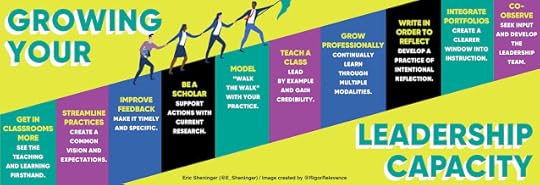
Visit Classrooms Routinely
This seems so easy yet is a constant struggle. Consider increasing the number of formal observations conducted each year and commit to a schedule to get them all done. We formally observed each of our teachers three times a year regardless of experience. Another successful strategy is to develop an informal walk-through schedule with your leadership team. I mandated five walks a day for each member of my team, and we used a color-coded Google Doc to keep track of where we visited and the specific improvement comments provided to each teacher.
Streamline Expectations and Eliminate Ineffective Practices
Think about establishing a shared vision, language, and expectations for all teachers. We did this by using the Rigor Relevance Framework. This will provide all teachers with consistent, concrete elements to focus on when developing learning activities. Get rid of the dog and pony show ritual of announced observations. If lesson plans are still collected, ask for them to demonstrate what will be done two weeks into the future. Consider less of a focus on lesson plans and more on assessment by collecting these two weeks into the future.
Improve Feedback
Provide at least one suggestion for improvement, no matter what is seen during an observation or walk-through. There is no perfect lesson. Suggestions for improvement should always contain clear, practical examples and strategies that a teacher can implement immediately. Timely feedback is also essential.
Be a Scholar
Being a scholar helps you as a leader to improve professional practice and puts you in a position to have better conversations with your teachers about their own improvement. This adds a whole new level of credibility to the post-conference. I made an effort to align every point of critical feedback to current research. As you come across research that supports the types of effective pedagogical techniques you wish to see in your classrooms, archive it in a document that you can refer to when writing up observations. I spent each summer as principal reading, researching, curating, and adapting this for use during the school year. It saved me time when it came to writing up observations and greatly improved my relationship with my staff as the lead learner.
Model
Don't ask your teachers to do anything that you are not willing to do yourself. This is extremely important in terms of technology integration in the classroom and professional learning to improve practice. If a teacher is struggling with their assessments, don't just say you need to work on building better ones. Either provide an example that you have created or co-create an assessment together.
Make Time to Teach a Class
This can be accomplished regularly during the year or by co-teaching with both struggling and distinguished teachers. During my first couple of years as an administrator, I taught a section of high school biology. This is leading by example at its best. It also provides a better context for the evolving role of the teacher in the digital age. A leader who walks the walk builds better relationships with staff and will be in a much better position to engage staff in conversations to improve instruction.
Constantly Seek Out Ways to Grow
Attend at least one conference or workshop a year that is aligned to a significant initiative or focus area in your school/district (the annual Model Schools Conference is a fantastic option). Try also to read one education book and another related to a different field such as leadership, self-help, or business. So many powerful lessons and ideas can be gleaned once we venture outside the education silo. To complement traditional means of professional learning, work to create or further develop a Personal Learning Network (PLN).
Reflect Through Writing
Writing has enabled me to process my thinking resulting in a more critical reflection of my work in relation to teaching, learning, and leadership. Our reflections assist us with our growth and can also be catalysts for our staff and others to reflect on their practice or grow professionally. Having teachers write a brief reflection prior to the post-conference is an excellent strategy to promote a conversation on improvement that isn't one-sided.
Integrate Portfolios
Portfolios were a requirement for my teachers and complimented our observation process nicely. They provided more clarity and detail on instruction over the entire course of the school year. Portfolios can include learning activities, assessments, unit plans, examples of student work, and other forms of evidence to improve pedagogical effectiveness. They can also be used to validate good practice.
Co-Observe
During the first quarter of each year, I co-observed lessons with members of my administrative team. This was invaluable for many reasons. For one, we were able to utilize two sets of eyes during the observation, as some things will always be missed when done solo, no matter how much experience you have. This also allowed me to work with my team to help them improve their leadership. It also helped me grow as every conversation helped me further reflect on what I saw.
There is nothing more important than ensuring quality learning is taking place in our classrooms. The ten strategies presented can be implemented immediately to improve your leadership while enhancing the practice of those you serve.
February 20, 2022
Leading With a Swiss Army Knife Approach
How would one define great leadership? What are the characteristics of influential leaders? Each of these questions leads to various responses. I am sure that each of you reading this post can develop a quick list of critical characteristics or behaviors that one must utilize to help move people to where they need to be to improve culture and performance. Sure, some might naturally rise to the top, but the fact of the matter is that one is not necessarily better than the other. Influential leaders tend to be great because they understand each situation requires a different approach. Kendra Cherry provides an excellent synopsis below:
The situational theory of leadership suggests that no single leadership style is best. Instead, it depends on which type of leadership and strategies are best-suited to the task. According to this theory, the most effective leaders are those that are able to adapt their style to the situation and look at cues such as the type of task, the nature of the group, and other factors that might contribute to getting the job done.
Let me summarize the statement above. There is no one best way to lead. The landscape is changing at a frenetic pace, and this requires a multi-faceted approach, as detailed in Digital Leadership. The key is understanding when and how to apply what is needed in different situations, and there isn’t a better analogy, in my opinion than a Swiss Army knife. As a kid, I had one of these and loved the multi-functionality it provided. While I tended to use some of the tools more than others, different problems or challenges required a different gadget. Knowing what tool to select and when to use it helped to achieve success, even if it was just sawing small branches to make a habitat for all the creatures my brother and I collected as kids. It was always reassuring to know that one device could do so many things.
Leadership is a lot like a Swiss Army Knife. First, leaders need to understand what strategies are the most critical in leading change, improving outcomes, and developing a thriving culture. Second, they need to know when and where to employ these strategies based on the situation. Here is my attempt at creating the analogy.
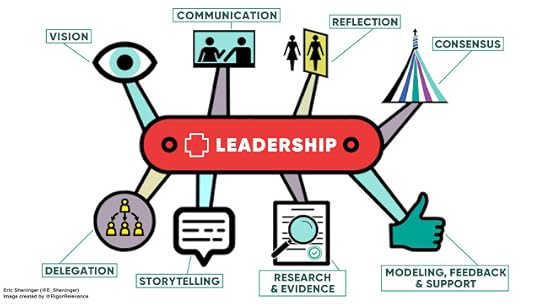
Communication (the right information at the right time the right way)
Consensus (sharing decision-making to build collective efficacy)
Storytelling (motivating and inspiring)
Modeling (practicing what is preached), Feedback (providing ways to grow and improve), and Support (professional learning, resources, empathy, time)
Research and Evidence (justifying changes to be implemented and validating strategies used to improve outcomes)
Vision (articulating where we are headed, how we’ll get there, and why)
Reflection (thinking about what we do, why we do it that way, and how it can be done better)
Delegation (building capacity by empowering others)
To be effective, great leaders understand that they must be flexible if success is the goal. While many of the elements above can happen simultaneously, different situations require a specific approach or strategy. Leading with a Swiss Army approach empowers leaders to identify the context or challenge and readily adapt to employ a personalized approach to solve a problem, move an innovative idea forward, or improve culture. In the words of Richie Norton, “That challenge you have right now...it’s not a wall; it’s a door. It's meant to be opened. Get a handle on the situation and open it.” Sometimes you need a different key to open the door.
February 13, 2022
Strength in Vulnerability
“Vulnerability is the core, the heart, the center, of meaningful human experiences.” - Brené Brown
Change is hard. It is even more challenging to sustain. While there are many obstacles to individual or system growth, fear and comfort tend to lead the pack. Both work to stymie a desire to improve for different reasons. Often, we are afraid of taking risks or embracing new ideas because they might not work out, resulting in a decrease in performance, outcomes, or morale. What might be will never be experienced if we are not open to trying. Then there is comfort, which is typically the enemy of progress. Hugh Jackman said something to this effect in The Greatest Showman. What can materialize is a false sense that our current actions or practices are still effective.
I shared the following in Disruptive Thinking:
Complacency has an insidious ability to inhibit our growth. When we are in a state of relative comfort with our professional practice, it is often difficult to move beyond that zone of stability and, dare I say, “easy” sailing. If it isn’t broke, why fix it, right? Maybe we aren’t pushed to take on new projects or embrace innovative ideas.
While there is no silver bullet when it comes to change and growth, both become harder to achieve when we are not vulnerable. While the standard view is that this is a sign of weakness, it is precisely the opposite. Strength comes from stepping into the unknown and putting yourself in a position to tackle adversity head-on as a means to an end – getting better! Vulnerability as a catalyst for change and springboard for growth comes from:
Stating you don’t knowAsking for helpAdmitting you were wrong Sharing mistakesNot hiding emotions (it’s ok to shed a tear)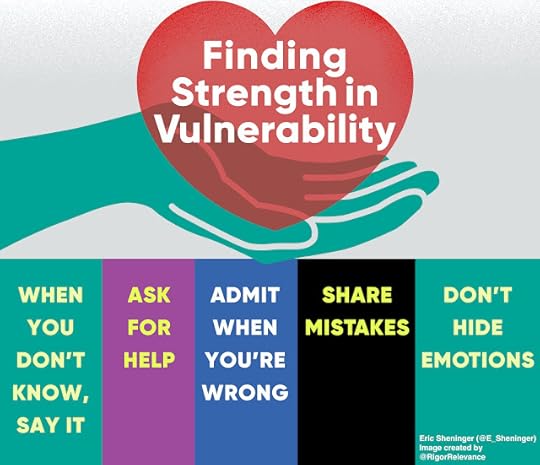
The list above is all about being human and using perceived weaknesses as a bridge to not only build powerful relationships with others but also to actively overcome fear and complacency as a result of comfort. As I mentioned earlier, change will be even more difficult, or in some cases impossible, if vulnerability isn’t seen as an asset. Maz Dela Cerna shares the following:
Putting yourself out there, taking that leap, and showing vulnerability take a lot more courage and strength than to keep quiet and do nothing. It shows strength when you can swallow your pride and ask for help. It’s perfectly natural to experience tough times and to not always be on a high. It takes guts to put yourself out there and launch an idea. While you may be vulnerable and open yourself up to failure, you may also succeed.
I recently joined Tom Murray on the Future Ready podcast to share some of my thoughts on the topic, which you can view below.
There is absolutely no shame in being vulnerable when it comes to change. In the words of Brene Brown, “Vulnerability is about showing up and being seen. It’s tough to do that when we’re terrified about what people might see or think.” If growth is an individual as well as a collective goal, which it should be, then embrace vulnerability and be the change you wish to see in education.
February 6, 2022
Don’t Use a Lot Where a Little Will Do
The title of this post is a well-known proverb that carries a great deal of weight during times of adversity, struggle, or uncertainty. I don’t know of a single person who really wants to take on more work, especially during a pandemic. Pie in the sky strategies, fluffy concepts that are dead on arrival because they ignore critical context or lengthy books with little tangible examples do little to alleviate stress. There is no better time than the present to pause, reflect, and focus on simplicity as a means to improve practice.
In Disruptive Thinking in Our Classrooms, I honed in on research-based strategies that have withstood the test of time in addition to emerging strategies such as personalized learning. While I was afforded the opportunity to go into depth in the book, the fact of the matter is less can be genuinely more.
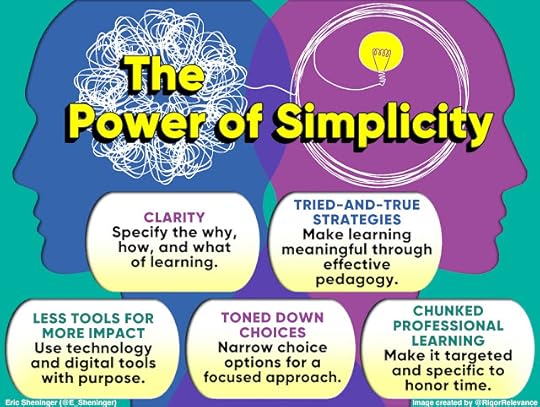
Clarity
It is critical that students understand not only what they are expected to learn but also why they are learning the concept(s) and how it will be used outside of school. A straightforward way to set this stage is to unpack the standard(s) into a learning target. I shared the following in Disruptive Thinking:
These frame the lesson from the students’ point of view and are presented as “I can” or “I will” statements. They help kids grasp the lesson’s purpose—why it is crucial to learn this concept, on this day, and in this way. Targets help to create an environment in which students exhibit more ownership over their learning. Critical questions framed from the lens of the learner include:
Why is this idea, concept, or subject vital for me to learn and understand?How will I show that I have learned, and how well will I have to do it?What will I be able to do when I’ve finished this lesson?
Tried and True Strategies
While a learning target is a significant step to ensure clarity, it is the use of effective pedagogical techniques that lead to meaningful learning. Reviewing prior learning, checks for understanding, and closure have and always will be valuable components of a lesson. Be sure to check out this post on the topic that adds context to the image below.
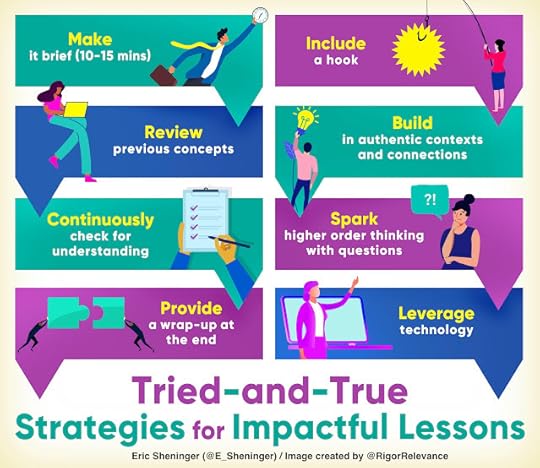
Fewer Tools for More Impact
It’s not how much technology you use in the classroom that matters, but the degree to which students use it in a purposeful way. Too much of a good thing tends to have drawbacks, which tend to increase when not aligned with sound pedagogy. When it comes to technology, less is definitely more. Consider settling on one or two tools to complement and enhance the instructional strategies you use daily. For a list of some of the tools I see teachers use the most with a high degree of efficacy by instructional strategy, click HERE.
Toned Down Choices
I am a huge fan of personalization through blended learning as a way to ensure equitable learning in and out of the classroom. All of the schools I coach in have found ways to successfully implement these strategies with a high degree of efficacy. One stumbling block is time. Educators love choice boards and will spend hours creating them with either six or nine options. While these can be very effective in empowering learners, the fact is that you don’t need a full-fledged board. Consider having only two are three options for them to choose from to complete. You can also consider utilizing must-do/may-do or a playlist with only a few options.
Chunked Professional Learning
Time is the most precious resource for educators these days. Lengthy workshops or being pulled out of schools for even a day isn’t always practical or beneficial. Just like with direct instruction, chunking professional learning allows for needed support that is more targeted and specific. Single concepts or strategies can be presented, as well as modeled, in twenty-minute blocks. Creating an asynchronous course in a learning management system (i.e., Canvas, Schoology) or Google Classroom is another excellent way to chunk learning into manageable pieces.
In the words of Leonardo da Vinci. “Simplicity is the ultimate sophistication.” It also helps ensure that an idea, strategy, or implementation helps achieve its intended goal.
January 30, 2022
Model What You Expect
One of the most powerful teaching and leadership strategies is the act of modeling. It goes beyond just telling people what to do by instead showing them how to do it as a means to either support learning or change. In the classroom, modeling aids in making concepts clear where students learn by observing. I shared the following in Disruptive Thinking in Our Classrooms:
Modeling is a pedagogical strategy whereby the teacher or student(s) demonstrates how to complete tasks and activities related to the learning target. It describes the process of learning or acquiring new information, skills, or behavior through observation rather than through trial-and-error attempts or direct experience. Learning, in many cases, results from observation (Holland & Kobasigawa, 1980). Modeling is one of the most effective ways to learn any new skill or knowledge (Bandura, 1986). Showing learners how to solve a problem or tackle a concept is often much more helpful than merely telling them.
There is an array of strategies that can be used. Below is a quick list:
I Do, We Do, You DoThink AloudsExplicit ModelingIn terms of leadership, example is everything when it comes to empowering people to change. Telling people what to do might work in the short term but can lead to instability down the road. While the "why" might initially motivate, the "how" empowers others to take action. I shared the following in Digital Leadership:
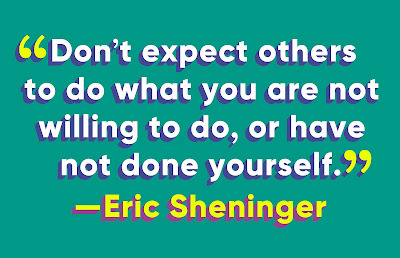
Effective leaders don't tell people what to do. Instead, they take them where they need to be. Modeling is one of the most powerful strategies to initiate and sustain change. For example, if you want your staff to use a communications tool like Remind regularly to keep students and parents abreast of assignments, then you should be using social media daily to communicate with stakeholders. This is just one example. Leading professional learning, teaching a lesson, participating in a PLC (professional learning community), or flipping a faculty meeting are all ways that leaders can model the same practices that they want their staff to embrace.
I have been doing a great deal more modeling in my coaching role as of late. Whereas in all my keynotes, presentations, and workshops, I provide evidence (pictures and videos) from the field that illustrate changes to practice, a coaching cycle gives me more time to roll up my sleeves and model. The bottom line is that if I can only talk about it, then I shouldn't be coaching or leading the professional learning. In my opinion, this statement pertains to any author or speaker. As I late, I have successfully modeled the following:
Taught multiple 4th and 5th-grade classes to demonstrate how technology can be used to empower student voice as part of an SEL lesson.Created and taught a model lesson to K-12 educations on voice and choiceDeveloped and had educators engage in a personalized learning task. The options included a choice board, playlist, or one-on-one conferencing with me to get feedback on lesson and unit plans. This was a direct follow-up to the model lesson for educators.Worked with a high school principal to create an asynchronous course in Google Classroom on personalized learning. I created a template while providing sample activities and questions as a foundation. Creating the course was in response to how time-strapped educators are while also expressing a desire for meaningful professional learning.Conducted numerous non-evaluative observations and walk-throughs to illustrate how I would provide feedback to teachers.No matter your role, always look to model what you expect of others. In the words of Frank Sonnenberg, "You send a message by what you say and what you do. If words aren't supported with consistent actions, they will ring hollow."



